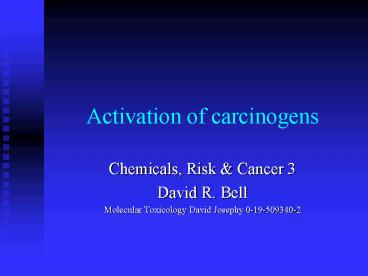Activation of carcinogens - PowerPoint PPT Presentation
1 / 20
Title:
Activation of carcinogens
Description:
Mutations in the ras oncogene with BaP are typified by G-T transitions at codon 12 or 13 ... Unusually, these cluster at codon 249 ... – PowerPoint PPT presentation
Number of Views:47
Avg rating:3.0/5.0
Title: Activation of carcinogens
1
Activation of carcinogens
- Chemicals, Risk Cancer 3
- David R. Bell
- Molecular Toxicology David Josephy 0-19-509340-2
2
Coal tar
- Coal tar, coal dust, and some petroleum oils are
highly carcinogenic - Percival Potts and coal sweeps
- Use animal bioassay to separate the active
ingredients - Principally high molecular weight hydrocarbons
with multiple rings (polycyclic aromatic
hydrocarbons)- which are not reactive
3
Benzo(a)pyrene
1
Bay region
2
10
3
9
4
8
5
7
6
K region
High electron density at Bay and K regions Planar
molecule
4
Benzo(a)pyrene
- Typical PAH
- Ubiquitous
- Coal tar, organic matter
- Formed during combustion of organics
- Cooking !
- Oils, especially used at high temperature
- Chemically inert
- Principal active agent in coal tar
5
B(a)P- an electrophile
- The Millers thought that BaP must form an
intermediate electrophile - PAHs often become fluorescent after reaction
- Carcinogens bind to proteins in target organs to
produce fluorescent protein adducts - Also bind to DNA
- Formation of an Ultimate Carcinogen, which is an
electrophilic metabolite of the parent compound - Ca. 1950
6
B(a)P metabolism
Multiple sites of metabolism combination of
metabolism at multiple sites. Highly
complex metabolic pathways.
2
10
3
9
4
8
5
7
6
Hydroxylation- reactive phenols and quinones
7
The ultimate carcinogen
Cytochrome P450
O
B(a)P 7,8 epoxide
Epoxide hydrolase
P450
O
OH
OH
OH
OH
((anti))B(a)P 7,8 dihydrodiol 9,10 epoxide
B(a)P 7,8 dihydrodiol
8
The electrophile
OH
OH
OH
Cation at C10 is stabilised by the high electron
density in the bay region
9
Is BPDE important ?
- Analysis of B(a)P- DNA adducts
- BPDE should be more carcinogenic than BP
- Dose mice at birth and autopsy at 7 months. Lung
tumours/mouse are shown.
10
Adducts from B(a)P
- Adducts form on C10- N2 of dG using the BPDE on
DNA in vitro - The same adducts are formed in vivo on DNA
- Mutations in the ras oncogene with BaP are
typified by G-T transitions at codon 12 or 13
11
BaP adducts and smoking
- Look at population of controls and smokers
- Look at incidence of BaP adducts and cancer
- What is the relative risk of getting cancer if
you have BaP adducts ?
12
Aromatic amines
- Used extensively as dyes, and in chemical
processes - Azo dyes metabolised to aromatic amines
- Epidemiological detection of bladder cancer in
occupationally-exposed population
13
Aromatic amines
NH2
NH2
NH2
benzidine
1-napthylamine
CH3
CO
NH
NH2
2-napthylamine
2-acetylaminofluorene (AAF)
14
2-AAF activation
Ring hydroxylation detoxification
CH3
CO
P450
NH
CH3
P450
CO
CH3
N
CO
Nitrenium cation
N-OH
CH3
Sulfo- transferase
CO
N-OSO3H
15
Popular world cancers
- Liver cancer shows high incidence in tropical
regions - 1.5 per 105 in Australia
- 22 per 105 in East Africa
- Disease of younger people
16
Causes of liver cancer
- Hepatitis viruses (B)
- Fungal contamination of food
- Aspergillus flavus produce aflatoxins
- Highly potent liver toxins
- Liver carcinogens
17
Aflatoxin B1
Potent liver toxins excess aflatoxin leads to
liver necrosis. Liver carcinogens detect
as urinary DNA-aflatoxin, or in DNA or protein
adducts. Form N2-dG adduct
O
O
P450
O
O
H
OCH3
O
O
18
Epidemiology
- People with HBV infection have a greater chance
of HCC - People with urinary aflatoxin metabolites have a
greater chance of HCC - People with both HBV and urinary aflatoxin
metabolites have a much greater chance of HCC
19
p53 mutations
- Hepatocellular carcinoma has a high incidence of
p53 mutations - Unusually, these cluster at codon 249
- Mutations at 249 arise from a G-T transition,
typical of aflatoxin adducts
20
Activation of carcinogens
- Many important carcinogens require metabolic
activation - Multiple enzyme systems involved in activation
- Linkage from
- Chemical activation
- Adducts
- Specific mutations
- Cancer































